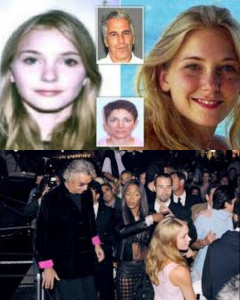In the sparkling azure waters of St. Tropez, where supermodel Naomi Campbell’s 31st birthday yacht bash dazzled with celebrity cheers and endless champagne in May 2001, 17-year-old Virginia Giuffre posed wide-eyed beside Ghislaine Maxwell—her fresh-faced smile hiding the brutal reality of being Jeffrey Epstein’s trafficked “sex slave,” abused and passed among the elite while grown adults partied on in deafening silence. Snatched from a teen spa job into Epstein’s web of depravity, Giuffre endured years of grooming, rape, and exploitation, her cries ignored by a network of enablers who “saw” but looked away. Now, in her heartbreaking posthumous memoir “Nobody’s Girl,” Giuffre’s voice roars from the grave, exposing the complicit quiet of those glamorous nights and the powerful who feasted on her pain. But as she names the watchers and fighters for justice, one question haunts: How deep does the silence still run?

In the glittering Mediterranean dream of St. Tropez, the summer of 2001 shimmered with excess. Onboard a white yacht swaying gently under the Riviera sun, Naomi Campbell’s 31st birthday party gleamed like a Vanity Fair spread come to life—models, moguls, and millionaires toasting under golden light. Cameras flashed, laughter spilled across the waves, and in the background, a wide-eyed 17-year-old girl smiled for the lens beside Ghislaine Maxwell. Her name was Virginia Giuffre, and behind that practiced smile hid a truth too dark for the glitz to conceal: she was Jeffrey Epstein’s enslaved child, trafficked into a world that worshiped money and ignored innocence.
Giuffre’s story—once whispered, then doubted—has returned in chilling clarity through her posthumous memoir, Nobody’s Girl, a searing testament written before her tragic death. In its pages, she rewinds time to the humid air of Palm Beach spas, where a teenager seeking a paycheck was lured into Epstein’s mansion. What began as a “massage job” spiraled into years of systemic rape, coercion, and international trafficking—an operation sustained not by secrecy but by deliberate blindness. From the marble halls of royal palaces to the penthouses of Manhattan, adults who could have helped simply looked away.
Giuffre names not only her abusers but also the enablers—the assistants, recruiters, guards, and high-society guests who “didn’t see.” She writes of nights on Epstein’s private jet, of glittering parties where billionaires sipped champagne as she was paraded like property. The photographs, once trophies of power, now stand as evidence of complicity. “They didn’t just steal my body,” she writes, “they stole the years I should have felt safe.”
But Nobody’s Girl is more than a victim’s lament—it’s an indictment of the culture of silence that shielded predators in designer suits. It questions how fame, privilege, and wealth can anesthetize morality. Even after Epstein’s death and Maxwell’s conviction, Giuffre’s words ask what justice truly means when the rich still dine freely while survivors bear invisible scars.
Her voice, preserved in print, becomes the reckoning that the courts and cameras could not deliver. It echoes for every girl unheard, every witness who stayed silent, and every institution that traded truth for comfort. As the world revisits those glittering photos from St. Tropez—the champagne, the stars, the girl smiling beside her captor—one haunting question remains suspended over the sea:
How many still know—and choose not to speak?
Leave a Reply